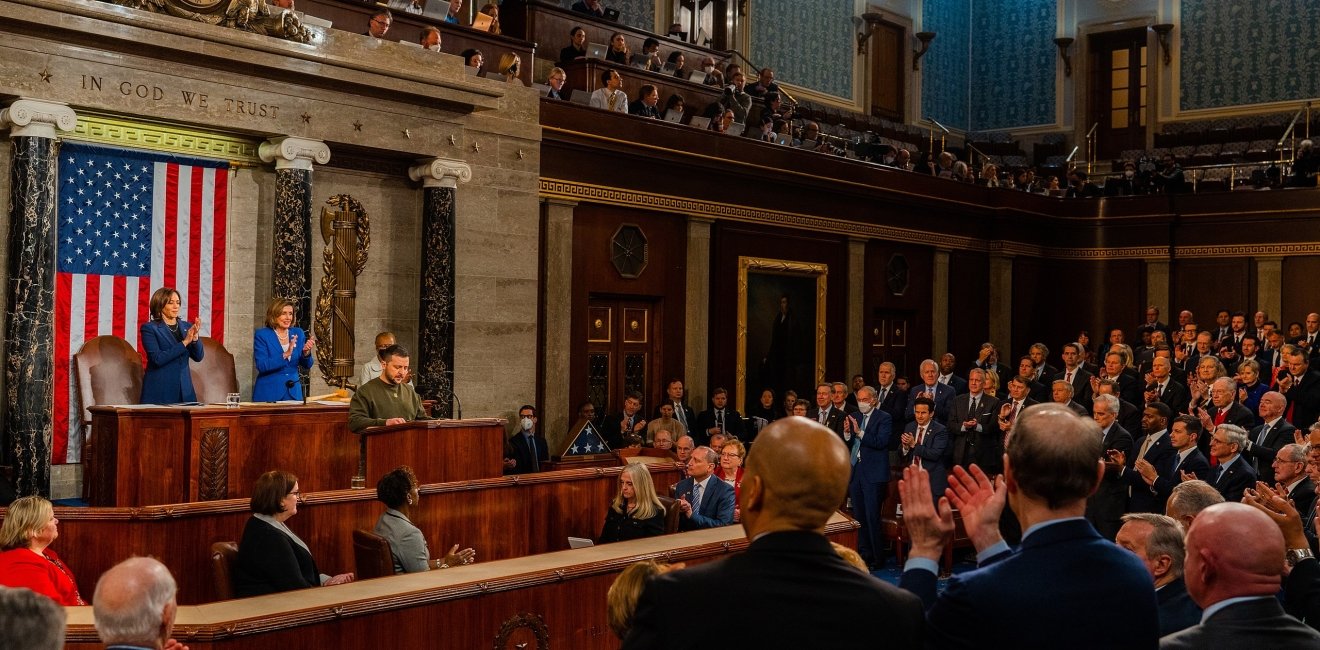On Saturday, April 20, the US House of Representatives passed a $95 billion package providing support to Ukraine, Israel, and Taiwan. The majority of this package, some $60.84 billion, is to address the war in Ukraine. This package was first introduced back in October, but has been stalled in recent months. From here, the package moves to the Senate where it is expected to pass unhindered and it will then go to the president’s office for signature. In the following compilation of expert quick takes, a diverse group of experts closely following Russia’s invasion of Ukraine and the security environment of Europe provide their analysis and reactions.
Rt Hon Baroness Catherine Ashton LG GCMG, Distinguished Fellow
The decision by Congress to send much needed support to Ukraine will be greeted with immense relief, foremost in Ukraine, followed closely by Europe. This is an important moment. First, it reinforces the US commitment to help Ukraine to defeat the Russian invasion; Second it tells Europe that the US remains its reliable partner. These signals matter, not just for the future of Ukraine but also to Europe where concerns about what Russia might do next remain high. And to Russia, this says the US is to be reckoned with in its determination to see the values of sovereignty, self determination and freedom upheld.
Klaus Larres, Fellow, Global Europe Program
Finally, the US House of Representatives has passed the delayed bill for supplementary aid for Ukraine. The package is worth $60.8 billion and is sorely needed in Ukraine. In the last few months Russia has made significant battleground gains. The Russian forces have gradually shifted the eastern frontline and managed to capture additional slivers of Ukrainian territory. The badly stretched Ukrainian forces were put on the defensive, lacking ammunition and anti-missile systems as well as personnel to push back the Russians.
Although the European Union and individual European countries, not least Germany and the UK, have recently provided substantial additional military and financial aid to Ukraine, the absence of supplementary US aid was badly felt at the Ukrainian frontline. Especially the missile defense systems to shoot down Russian drones which have recently attacked the Ukrainian energy grid and many civilian targets with a new ferocity, were sorely needed.
The US $60.8 billion supplementary aid bill will now also have to be passed by the US Senate. But Senate leaders have indicated that this will happen within a matter of hours and President Biden is expected to sign the bill into law shortly thereafter. The US Department of Defense has said for months that the weapons systems, the ammunition, and other aid has been assembled and is ready to be shipped out to Ukraine immediately. In all likelihood, the new US aid will arrive in Ukraine early next week. The new US aid will make a significant difference and will help Ukraine to defend itself and push back the invading Russian forces.
Michael Flaherty, Public Policy Fellow, Kennan Institute
Restarting lethal support from the US to Ukraine is critical for the Armed Forces of Ukraine (AFU). However, the long-term impact of additional support will depend on the predictability of it continuing. Over the past 7 months, Ukraine has lost the ground initiative due in large part to resupply delays from its allies. During that time, Russia has maintained a steady supply of munitions from its allies and transitioned from static defense to resuming offensive operations.
It remains unclear whether the AFU can regain the initiative quickly. One outcome is certain though. If the $60 billion appropriation from the US Congress is not routinely renewed, this weekend’s legislative action will simply be a band-aid for the Ukrainian war effort. Military planners cannot conduct offensive operations and extend lines of support into Russian occupied territory without stable, predictable resupply.
Given this, if support to the AFU continues to be a source of contentious politics, Ukrainian sovereignty will remain at risk. Without broad agreement among governing parties in the US and Europe that Ukraine’s survival is a critical collective security priority, Russian political warfare will find cracks to exploit. Preparing the next round of legislative support for Ukraine should begin now. Another 7-month delay in logistical support from the US or Europe will likely cost Ukraine the war.
While this seems dire, it is important to explain the time factor of war and the impact of delay to the publics in NATO member states. Citizens in the US and Europe should clearly understand that without military support, Russian troops will reoccupy Ukrainian towns and continue committing war crimes against Ukrainian citizens without consequence. It is a well-documented pattern. However, it is equally important to highlight that even with logistical delays, the AFU has continued to weaken Russian aerospace and naval forces and threaten Russian supply lines. A resumption of robust military support from the US and European countries members will help Ukrainian ground forces regain the physical and psychological edge necessary to take back the ground initiative.
Since Russian troops will not likely leave Ukrainian territory through negotiation, it is critical to continue giving Ukrainian troops the means to remove Russians by force.
Mariana Budjeryn, Global Fellow, Global Europe Program
After months of delay, $61 billion in Ukraine aid was finally unlocked by the US House of Representatives last weekend. While it is tempting to look back and lament the Ukrainian lives a timely decision could have saved, the more crucial question is how to make the most out of the billions now that they are available. Just as with the 2023 Ukrainian counteroffensive, there’s a danger of unrealistic expectations, especially since the issue of the Ukraine aid has become highly politicized in the United States.
Ukraine is likely to spend much of this money stabilizing the front and establishing firmer defenses to halt the slow but griding Russian creep in the east. It will likely move to replenish air defenses to protect its cities, its electrical grid, and civilian infrastructure that have been badly degraded by Russian missile and drone strikes over the past few months. Combined with a mobilization push, if successfully carried out, the US aid can also help train and regenerate Ukraine’s exhausted and depleted defense forces.
But the aid is not a magic bullet and the changes it can generate on the battlefield have their limits. Moreover, depending on the outcomes of the US presidential elections, further US support might be increasingly harder to come by. All the more reason to use this aid wisely, in a way that hedges again political uncertainties in the United States and Europe, with which this pivotal year 2024 is rife.
Robin Quinville, Director, Global Europe Program
Burden-sharing is a long-standing theme of US policy with our transatlantic partners. US pressure increased over the past ten years, after NATO codified 2% of GDP as the Alliance's defense spending standard in 2014. We have pressed Allies to contribute more to capabilities and readiness. We have asked countries with the most capable militaries to join or support action beyond NATO's borders. We have also asked transatlantic partners to contribute to reconstruction efforts following military action.
That’s why it isn't surprising Europeans have paid close attention as Congress debated Ukraine funding. Europe's threat perception changed fundamentally with Russia's invasion of Ukraine. Europe – both individual countries and the European Union – has stepped up both military aid and vital financial assistance to keep Ukraine's government functioning. Much of it is multi-year funding Ukrainians can count on. But for the past several months, Europeans have questioned whether Ukraine – and Europe – can count on the US commitment to burden-sharing.
European concern was highly visible at the Munich Security Conference. Then, the question was when the US would pass the funding package. But as weeks passed, the bigger question became whether the US would continue funding. Would the US continue to share the burden?
Europeans will welcome (with considerable relief) Congress’s decision to move funding forward. Delay has hampered Ukraine's military planning (as our Global Fellow Jack Watling outlines), just as debate in Europe and the US over provision of specific military equipment hampered earlier Ukrainian efforts in the fight. European assistance to Ukraine was structured to complement US efforts, as Europe ramps up its defense production over the course of the year.
In July, NATO’s Washington Summit will face – again – the question of what the Alliance is prepared to do for Ukraine. Allies will come prepared to show they are taking burden-sharing seriously (especially NATO’s 2% threshold). But Allies will also be wondering how solid the US commitment to burden-sharing is when it comes to European defense, given the difficulty of getting funding for Ukraine’s existential fight.
Jason C. Moyer, Program Associate, Global Europe Program
Ahead of the NATO Ministers of Foreign Affairs meeting in early April, Secretary General Jens Stoltenberg proposed codifying long-term support for Ukraine over a 5-year period using a special €100 billion fund. This proposal was met with mixed results–proponents saw this as a way of protecting support for Kyiv from the ‘winds of political change’ while others, notably the US, saw this as an overreach and a potential escalation by deepening NATO’s role in an active warzone. As this year’s uncertainty over future military support for Ukraine has demonstrated, it might be time to consider institutionalizing aid for Ukraine at the NATO level.
Dubbed the “Mission for Ukraine” proposal, Stoltenberg’s plan, should it be approved, would ramp up NATO’s direct involvement in supporting Ukraine. Support from Ukraine is organized and delivered by NATO member states–not the defensive military alliance itself. This was by design to avoid entangling the alliance in providing lethal aid to Ukraine. The proposal would also give the alliance control of the US-led Ramstein weapons support group and was the main source of contention with US decisionmakers. However, the US should welcome Europe stepping up to do more via NATO.
The US share of this €100 billion fund would be significantly less than the $60 billion passed by Congress. Notionally the fund would be financed based on NATO’s shared budget, meaning the US would only need to contribute about €16 billion (about $17 billion). As US support stalled, Europe has filled the gap and has now surpassed US assistance. The EU institutions and its member states have committed more than double the US financial support of Ukraine over a longer timespan (€155 billion through 2027 compared to €67.7 billion from the US). Even with the supplemental, the EU and its member states are still contributing more than the United States to Ukraine.
This special fund proposed by NATO is not a done deal nor are the details finalized. The proposal will be ironed out in the months ahead and presented at the Washington Summit in July, where all 32 allies will need to agree to it. However, this proposal demonstrates that reliable and predictable support for Ukraine is essential for their victory and represents an investment in continued US and European security.
Suzanne Loftus, Global Fellow, Kennan Institute
A bill with much-needed aid to Ukraine has passed in Congress after months of political battles that left the Ukrainian army at a battlefield disadvantage. Now, Ukraine will better be able to hold down its defense lines amidst Russian offensive operations.
While a positive development, the difficulty in passing this bill suggests continued challenges of this nature on the horizon. This necessitates two urgent policy shifts:
One, Europeans need to invest heavily in their own defense as Americans seem preoccupied with matters other than European security. This is fundamental both to secure long-term support for Ukraine and for European security amidst Russia's massive investments into its military.
The second is to re-strategize how this war is communicated to the American public to garner continued support for Ukraine. Without American aid, Russia will conquer more land and force Ukraine to capitulate. This will lead to a stronger Russia in terms of land, resources and military power. Without efforts to defeat Russia in Ukraine, the West will face a strong adversary on Europe's doorstep that considers itself at war with the West. An emboldened Russia may bring a host of new challenges to the European continent. In addition, it is important to convey that providing Ukraine with needed weapons is a direct investment into the American defense industry and does not negatively affect the average American's economic well-being nor does it directly impact our border security.
While the new aid package is a positive development, American aid needs to be secured for the long-haul to create an effective deterrent in Ukraine that ensures an eventual and impactful Russian setback and prevents a repeat invasion. This may be the only way to end the war, as negotiations do not appear to be a serious possibility given the incompatibility of each side's demands.
Peter B. Zwack, Global Fellow, Kennan Institute
More than anything else passing this funding bill provided a major morale boost to the Ukrainians - from soldiers, to population, to government. It also injected some hope and buttresses Ukraine’s extraordinary will to fight – critical intangibles that one cannot put a quantity or dollar sign against – within an increasingly worn down Ukrainian defense and society.
It also provides immediate practical military capability such as artillery rounds and air defense across the breadth of the battle space from trenchlines to defending cities and infrastructure that of which the currently overmatched Ukrainians are desperately short. It buys time for the added influx of even more advanced weaponry including advanced fighter planes and Long Range missiles in the near-mid future. It also reduces the risk of this aid being subsumed by what looks to be a bitter US 2024 Presidential election.
There will be bitter fighting over the year ahead and the Ukrainians have lost over a half year to reconstitute and refurbish as implacable Russia has rapidly been doing as it perseveres in its grinding war of attrition … but better late than never. Most importantly the Ukrainians know we and the free-minded world still tangibly have their back.
This was also crucial to show our allies who could also waver in that we are still “all in” with support to Ukraine and other threatened democracies such as Israel and Taiwan.
Passing this bill and the actions of our allies bill serves notice to the relentlessly revanchist Putin regime and their growing 21st century “axis” of China, Iran and North Korea that the unified free-minded world will not be divided and will stand up to aggression early which was the great failure of the late 1930s leading to grisly WWII in Europe and then the Pacific.
And finally, this moment presents a philosophical point for all of us, especially younger generations more distant from the bloody 20th century … namely “who are we, and what do we stand for?” Can we stay the course? Forestalled for now, I still fear imagining a few years from now a debate about “Who lost Ukraine'' and stinging questions about whether did the West and its global allies do all it realistically could to support a free-minded nation within our civilization fighting for its existential life thereby deterring a mortifying a 21st century Neville Chamberlin moment.
Authors

Former Vice President of the European Commission and former High Representative of the EU for Foreign Affairs and Security Policy

Richard M Krasno Distinguished Professor in History & International Affairs at the University of North Carolina at Chapel Hill

PhD Candidate, University of New Mexico; Lecturer, Political Science Department, University of New Mexico; former Senior Intelligence Officer, Office of Naval Intelligence.

Senior Research Associate, Project on Managing the Atom at the Harvard Kennedy School’s Belfer Center



Associate Professor of National Security Strategy, National War College, National Defense University; Former Professor of Strategic Security Studies, George C. Marshall European Center for Security Studies

Former U.S. Army Brigadier General, served in Moscow from 2012 to 2014 as the U.S. senior defense official and attaché to the Russian Federation

Global Europe Program
The Global Europe Program is focused on Europe’s capabilities, and how it engages on critical global issues. We investigate European approaches to critical global issues. We examine Europe’s relations with Russia and Eurasia, China and the Indo-Pacific, the Middle East and Africa. Our initiatives include “Ukraine in Europe”—an examination of what it will take to make Ukraine’s European future a reality. But we also examine the role of NATO, the European Union and the OSCE, Europe’s energy security, transatlantic trade disputes, and challenges to democracy. The Global Europe Program’s staff, scholars-in-residence, and Global Fellows participate in seminars, policy study groups, and international conferences to provide analytical recommendations to policy makers and the media. Read more


Kennan Institute
After more than 50 years as a vital part of the Wilson Center legacy, the Kennan Institute has become an independent think tank. You can find the current website for the Kennan Institute at kennaninstitute.org. Please look for future announcements about partnership activities between the Wilson Center and the Kennan Institute at Wilson Center Press Room. The Kennan Institute is the premier US center for advanced research on Eurasia and the oldest and largest regional program at the Woodrow Wilson International Center for Scholars. The Kennan Institute is committed to improving American understanding of Russia, Ukraine, Central Asia, the South Caucasus, and the surrounding region through research and exchange. Read more

Explore More
Browse Insights & Analysis
Smart Take | Congress Sends Russia a Message by Passing US Aid Package for Ukraine

Hitting the Reset Button in the Indo-Pacific




